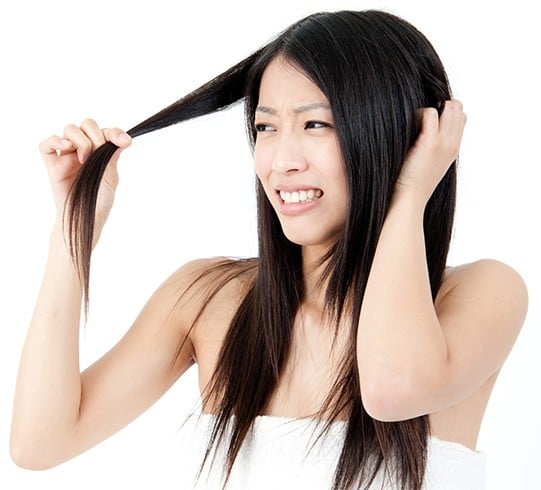Hair Loss Causes: Reasons It Happens in Women and Men
Table Of Content

For women who are experiencing a receding hairline (frontal fibrosing alopecia), talk with your doctor about early treatment to avoid significant permanent baldness. It's typical to lose some hair every day as part of your hair’s usual growth cycle. For most people, the lost hair grows back, and you maintain a full head of hair. But illness, hormonal changes, stress, aging and inherited conditions can interfere with your hair’s growth cycle. More hair falls out, but new strands don’t always grow back.
Can You Stop Hair Loss Once It Begins?
More research is needed before definitive claims can be made regarding its effectiveness. Female pattern baldness often results in thinning all over the scalp and might look like widening or thinning around the part. It typically occurs after age 65 but, for some females, it can begin early in their lives.
Top doctors in ,
If that's the case, a weather-induced hair die-off could hasten that male- or female-patterned thinning as new hairs come back smaller or not at all, he says. So if baldness runs in your family, or if you notice an increased rate of loss when baldness was already a concern for you, see your doctor. If you have healthy hair on the back or side of your head, a doctor can surgically remove hair strands from those areas and graft them into your scalp in a bare area. It’s another expensive treatment that isn’t generally covered by insurance, but it tends to be a long-lasting solution.
Follow Mayo Clinic
Here's How to Handle Thinning Hair, According to Experts - The Cut
Here's How to Handle Thinning Hair, According to Experts.
Posted: Thu, 22 Jun 2023 07:00:00 GMT [source]
Of the latter are beta-blockers (e.g., Inderal), retinoids, anticoagulants (Warfarin and others), and Carbatrol (carbamazepine). With new techniques, many women benefit from hair transplantation surgery. But there are risks, including infection or shock that can cause hair to fall out of the transplanted areas.
What questions should I ask my healthcare provider?
But finding the right formula isn't a matter of simply choosing a product off the shelf and hoping that it works. First, it helps to understand what’s causing your hair changes. On the whole, it’s important that you speak with your doctor about any symptoms you’re experiencing. A dermatologist can provide a proper diagnosis, and select a personalized treatment that will help restore health to you hair and scalp. CCCA and LPP fall under the umbrella of lymphocytic scarring alopecia.
Stay on top of latest health news from Harvard Medical School.
But we need more studies into their safety and effectiveness for long-term use. Taking hormones can change hair growth all over your body. Masculinizing hormone therapy (taking testosterone) may cause hair loss within a year, and the effects aren't reversible if you stop hormone treatment.
During telogen effluvium, more hair than usual falls out, leading to thinning of the hair, but it's typically reversible once the underlying cause is addressed. Women with androgenetic alopecia will usually experience gradual thinning of the hair, typically on the top of the scalp and some women notice their hairline receding. The most common cause of hair loss in women is female-patterned baldness (androgenetic alopecia).
Causes of Thinning Hair in Men and Women

Below are some frequently asked questions about hair loss. A doctor may recommend dietary changes and supplements to treat a nutritional deficiency. Treatment for this condition depends on the cause but may include a topical solution of minoxidil (Rogaine).
Alopecia areata affects up to 6.8 million people in the U.S. By Sarah Jividen, RNJividen is a freelance healthcare journalist. She has over a decade of direct patient care experience working as a registered nurse specializing in neurotrauma, stroke, and the emergency room. Omega-6, on the other hand, is important for overall skin health, which might benefit the scalp. Omega-3 and omega-6 fatty acids are called essential fatty acids. In cases of malnourishment or with certain eating disorders, new hair may fail to generate from follicles.
A blood test can help determine if you have a nutrient deficiency. Perhaps the cheapest method of trying to get thicker hair is scalp massage. It doesn’t cost anything, and if done correctly, it isn’t harmful. In some cases, an early diagnosis can increase chances of regrowing hair. AARP is a nonprofit, nonpartisan organization that empowers people to choose how they live as they age. Michelle Crouch is a contributing writer who has covered health and personal finance for some of the nation’s top consumer publications.
This article will focus primarily on hair loss in cis women. The information in this article will also apply to you if you were assigned female at birth and have never had hormone replacement therapy (HRT). Trans women and trans men who have used HRT may have additional risk factors for hair loss that are not covered here. Alopecia areata is an autoimmune condition that causes hair to fall out suddenly. The immune system attacks hair follicles, along with other healthy parts of the body. Telogen effluvium is usually a temporary condition that resolves over time, but it is advisable for people to contact a doctor to determine the cause.
“For sensitive or acne-prone skin, either frequent pillowcase changes or wearing a hair bonnet after serum application may be helpful,” she says. It’s a good idea to see a doctor if your child is dealing with hair loss in order to get a proper diagnosis and rule out potential medical conditions. If your child is experiencing hair loss, it’s a good idea to visit a doctor. They can help you determine if there’s a medical cause leading to hair loss or if it’s caused by genetic factors. Hair loss caused by a thyroid condition usually appears as a uniform thinning across your scalp.
There are several types of hair loss, and it can affect adults of any gender and even children. You may lose hair just on your head or from your body as well. While hair thinning might not always lead to visible baldness, it can still significantly impact the overall look and feel of the hair. Both hair loss and hair thinning can be influenced by various factors, including genetics, hormonal changes, medical conditions, and lifestyle factors. One example is alopecia areata, which is an autoimmune disorder where your immune system attacks hair follicles, causing thinning hair and sudden hair loss. Depending on the severity, hair loss may be mild or patchy, or more significant.
Left untreated, a sexually transmitted infection (STI) can lead to hair loss. Left untreated, syphilis can cause patchy hair loss on the scalp, eyebrows, beard, and elsewhere. A few months after giving birth, recovering from an illness, or having an operation, you may notice a lot more hairs in your brush or on your pillow. This can also happen after a stressful time in your life, such as a divorce or death of a loved one. When a man has hereditary hair loss, the first sign is often a receding hairline or bald spot at the top of his head.
In these cases, the hair loss is often reversible when medication or treatment is stopped. Spironolactone is another medication your doctor may prescribe for hair regrowth and to keep hair loss from getting worse. Hair growth naturally slows with age, so you may notice thinning. If you think you have age-related hair loss, talk to your doctor about treatment early on. Some women may even notice hair growth changes after going off hormonal birth control pills. Hormonal changes of any kind, particularly falling estrogen levels, can temporarily disrupt the hair life cycle.
Comments
Post a Comment